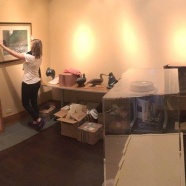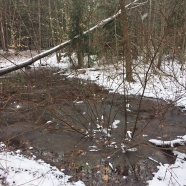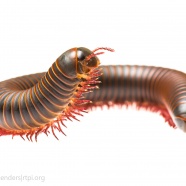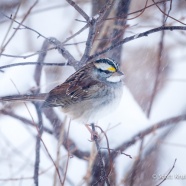Installation – The Weilers’ Evolution: A Father and Son’s Artistic Journey
RTPI’s Director of Exhibits & Special Collections, Jane Johnson, is busily installing our upcoming exhibit:”The Weilers’ Evolution: A Father and Son’s Artistic Journey”. A little ways to go before the show opens on Friday still, but it will be ready and it will be spectacular!!
Read MoreSpring Salamander
Hey look – a hot-dog with eyes! Wait, that’s a Spring Salamander (Gyrinophilus porphyriticus)! This large, lung-less salamander is a common resident in the many springs and streams that run through our local forests. It’s stature and bright coloration make it stand out, but also serve as protection from predators. Spring salamanders can grow to over eight inches in length and produce noxious skin secretions while using their color to mimic even more toxic species. It isn’t a salamander any predator would want to mess with, and it probably wouldn’t taste anything...
Read MoreWinter’s Not Over Yet
The fresh blanket of snow across the Western New York landscape is a good reminder that winter isn’t over just yet. However, some of our resident amphibians have been receiving crossed signals due to recent increases in daylight hours and above average temperatures; we have actually gotten reports of salamanders and frogs moving to nearby ponds and vernal pools to lay their eggs. With this weekend’s dropping temperatures, local pools have started to ice over indicating freezing temperatures near the surface. The eggs of some amphibian species are able to cope with fluctuating spring...
Read MoreWill the Big Night be Coming Soon?
Have you seen any signs of spring yet? We certainly have! Robins are actively feeding, red-winged blackbirds are beginning to sing, and it won’t be long before our resident salamanders come out from their winter refuges. Conditions have to be just right to entice them out from under their chosen cover objects; a warm 40° night with rain sets the stage for spotted salamanders to begin their migration. Will we soon see the required circumstances to set this charismatic species on the move? Keep an eye on the weather and another on nearby pools and ponds so as not to miss the big...
Read MoreRoly-poly-pede
This Giant Millipede (Narceus americanus) doesn’t really have 1,000 legs. However, like all millipedes, it has two pairs of extremities on each of its body segments (centipedes always have only a single pair per body segment). Unlike their centipede ‘cousins’, millipedes lack the modified jaw-like first pair of legs that predatory centipedes use to catch and sometimes envenomate their prey. Instead, millipedes defend themselves by rolling into a tight spiral and/or using chemical defenses that can include cyanide! Worst case scenario, handling one of these beautiful ‘roly-poly-pedes’...
Read MoreWhite-throated Sparrow
Here is a photo of a White-throated Sparrow (Zonotrichia albicollis) toughing it out in a recent snowstorm. Despite the fact that we were in the middle of February, this bird was already sporting its spring courting plumage; evidenced by its bright white throat and vibrant yellow lores. This is one of the first species you can expect to hear singing at the end of winter; their “oh-sweet-Canada” or “poor-Sam-Peabody” tune resonates from the brush. In some cases you might see White-throated Sparrows year-round – some birds will overwinter in the Northeast and head...
Read More









